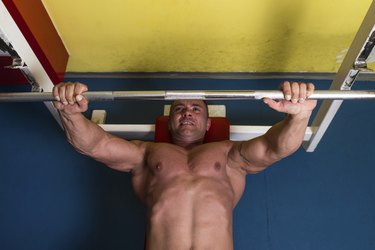
Your shoulder is actually made up of three separate joints -- the acromioclavicular, glenohumeral and sternoclavicular joints -- of which your collar bone, or clavicle, is an intricate part. These joints provide movement for a bench press, which typically strengthens your chest, shoulders and triceps muscles. Keeping your hands close together or rounding your shoulders puts too much stress on your clavicle and other parts of your shoulder joint, leading to injury.
Narrow Grip
Video of the Day
The way in which you grip the bar will directly affect certain muscles and joints in your shoulder. When you perform a narrow grip bench press, your hands are directly above your shoulders. Pressing weight in this position puts stress on your acromioclavicular -- AC -- joint the meeting of your collarbone and part of your shoulder blade. Though a narrow grip bench press targets the inner portion of your chest muscles, it puts tremendous strain on your AC joint. If you continue to stress this joint, degenerative arthritis of the AC joint and chronic shoulder pain can result.
Video of the Day
Wide Grip
If you have collar bone pain, perform a bench press with a wider grip, decreasing the strain on your AC joint. This positioning potentially builds up the more lateral pectoralis muscle, or the part of the muscle toward the arm. The majority of the work is done by the pectoralis muscle, more effectively isolating and targeting your chest; you cannot use your triceps or other arm muscles to help lift the bar. To find the correct position, place your hands on the bar directly above your shoulders, then move them out one to two hand-widths outward.
Proper Bench Press Form
Rounding your shoulders or exhibiting improper form can increase your risk for injury. The American Council on Exercise recommends lying on your back with your feet flat on the floor and the bar above your eyes. Pull your shoulders down and back, bringing your shoulder blades closer together to make a firm connection with the bench. The back of your body -- your head, shoulders and buttocks -- as well as your feet should stay in contact with the bench and the floor, respectively, throughout the exercise. Lifting your shoulders off the bench as you perform the press movements can result in injury to a number of muscles or ligaments in your shoulder.
Pain Relief
If you experience pain while performing an exercise, stop the exercise or decrease your intensity; do not push through the pain. If pain persists, even at rest, see a doctor. Applying ice packs can reduce swelling and inflammation. Avoid exercises that aggravate your pain. Ask a personal trainer about alternatives to the bench press and how to properly perform the exercise.